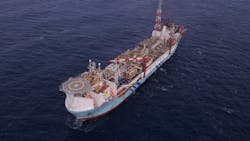Offshore staff
OSLO, Norway – DNV GL and Bluewater are co-operating on a pilot project involving the use of hybrid digital twin technology to predict and analyze fatigue in the hull of an FPSO in the North Sea.
They aim to validate and quantify the benefits of creating a virtual replica of the FPSO in order to optimize the vessel’s structural safety and support risk-based inspection (RBI).
Bluewater’s FPSO Aoka Mizu, currently operating at the Lancaster field, west of Shetland, will be used for the project.
DNV GL said its domain experience, inspection capabilities and digital analytics and modeling enable monitoring of the asset’s hull structure during operation without having to rely on costly routine inspections.
The concept, known as ‘Nerves of Steel’, involves combining various data sets (external environmental data or local sensor data) with digital models of the asset to develop a hybrid replica model of the vessel’s structure.
This can be used in real-time to monitor the vessel’s condition, identify and monitor high-risk locations, and to plan cost-efficient maintenance and inspection.
Hybrid twin technology uses numerical design models and data from actively recorded strain gauge sensors onboard the FPSO that are said to provide a full understanding of the accumulative loading and current state of the FPSO structure.
Computer-simulated modeling blended with real-time data is then streamed to the operator via DNV GL’s Veracity data platform or an existing data transfer solution.
DNV GL’s visual dashboard provides Bluewater with data on stresses in the hull’s structure, and information that can be used to identify areas at relatively higher risk of cracks or deformities. The information, which is constantly recorded, can be accessed and analyzed to support decisions and to enact inspections based on risk priority.
“Like an insurance policy, the hybrid digital twin can potentially save millions by avoiding the costly and possibly catastrophic repercussions of ill-informed integrity management by pre-empting and preventing detrimental damage,” said Francois-Xavier Sireta, technical lead for naval architecture and principal engineer, DNV GL – Oil & Gas.
“For an asset operating in a harsh environment, where the loads play an important part in the possible degradations…, using data from the site as a basis for optimized inspection planning, alarms for extreme events and asset suitability for life extension is crucial.”
10/12/2020



